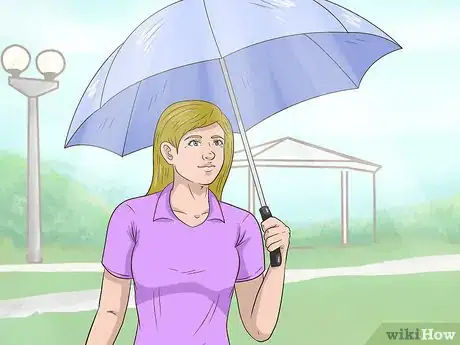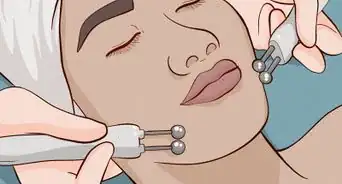This article was co-authored by Mohiba Tareen, MD. Mohiba Tareen is a board certified Dermatologist and the founder of Tareen Dermatology located in Roseville, Maplewood and Faribault, Minnesota. Dr. Tareen completed medical school at the University of Michigan in Ann Arbor, where she was inducted into the prestigious Alpha Omega Alpha honor society. While a dermatology resident at Columbia University in New York City, she won the Conrad Stritzler award of the New York Dermatologic Society and was published in The New England Journal of Medicine. Dr. Tareen then completed a procedural fellowship which focused on dermatologic surgery, laser, and cosmetic dermatology.
There are 7 references cited in this article, which can be found at the bottom of the page.
This article has been viewed 34,124 times.
Whenever your skin is exposed to the sun, there is a chance that you could get tan. Avoiding excessive exposure to the sun’s rays is a good way to avoid getting tan, plus it helps prevent skin cancer and early aging.[1] If you do spend time outdoors and still want to avoid getting tan, invest in some UV-resistant clothing, apply sunscreen regularly every 2 hours, and try to plan your activities outside of the brightest hours of 10 am to 4 pm. There are lots of small habits you can incorporate to help protect your skin from the sun!
Steps
Avoiding Sunlight Exposure
-
1Use SPF 30 or higher sunscreen every day, regardless of the weather. The sun’s rays can still hurt your skin even when it’s cold, rainy, or cloudy outside. Even if you’re not planning on being outside for long, your skin can still benefit from the regular application of sunscreen.[2] Choose a product that is SPF 30 or higher and that offers protection against both UVA and UVB radiation. Apply it to your face and any other areas of your body that won’t be covered by clothes.[3]
- Don’t forget your lips! Use a lip balm every day that contains SPF to keep your lips from getting sunburnt.
- A lot of cosmetic brands offer regular- or tinted-SPF moisturizers that you can use on a daily basis to help protect your skin. These may be better for your skin if you’re prone to acne.
-
2Avoid being outside while the sun is at its strongest. The hours from 10 am to 4 pm are generally the ones during which the sun’s rays are at their strongest. If you’re going to spend time outside, try to do so during the early morning or late evening hours to avoid getting a tan.[4]
- Pay attention to the length of your shadow—if it’s shorter than you, the sun is shining strongly. If it’s longer than you, that means the rays aren’t as dangerous.
Advertisement -
3Wear a large, floppy hat and UV sunglasses when you’re outside. These accessories will help protect your eyes, face, and even your shoulders from unwanted sun exposure.[5] A burn or tan can occur within 15 minutes of being outside even if you don’t feel the effects right away, so take precautions even when you’re taking a short walk or spending a little bit of time outside.[6]
- Don’t forget to wear those sunglasses while you’re driving. The reflection of the sun off of asphalt or concrete can actually burn your eyes!
-
4Find shade or use an umbrella if you have to be outside. If you are going to be outdoors during those peak 10 am to 4 pm hours, make it a point to spend time in the shade. If you can’t access a shady spot, bring an umbrella with you to block out the sun’s rays. This will help prevent unwanted sun exposure.[7]
- You can still get a tan even when you’re in the shade, so don’t forget to wear your sunscreen.
-
5Choose darker, closely-woven clothing to keep the sun off of your skin. You can even look for clothes that have an Ultraviolet Protection Factor (UPF) rating. White or light-colored clothing let through more UV rays than darker shades do. Even if it’s warm out, choose clothing options that are lightweight but that will still cover the majority of your skin for optimal protection.[8]
- Staying out of the sun altogether is the most surefire way to not get a tan, but it’s nearly impossible to have zero sun exposure. Take a little extra care when you get ready for your day to choose clothes that’ll help protect your skin, regardless of what your plans entail.
Protecting Your Skin During Outdoor Activities
-
1Reapply sunscreen every 2 hours while you’re being active outdoors.[9] If you’re sweating a lot or spending time in the water, reapply the sunscreen every hour. Choose a sunscreen with SPF 30 or higher, and pick one that provides protection from both UVA and UVB rays.[10]
- For optimal protection, put on sunscreen about 30 minutes before you actually go outside, and use it anytime you’re going to be outdoors for more than 15 minutes.
-
2Wear protective clothing even when it’s warm outside. If you can, wear clothes that provide UV protection, and choose items that cover as much of your body as possible. Of course, you want to avoid overheating, so use your best judgment to choose what attire is right for you.[11]
- For example, if you’re playing soccer outdoors in the summer, you could choose to wear a high-collared T-shirt and athletic pants rather than a tank top and shorts.
-
3Plan ahead based on the activity you’ll be doing. What you wear, where you apply extra sunscreen, and how often you reapply the sunscreen can all be dictated by the actual outdoor activity you’re going to participate in. For example:[12]
- Biking: the back of your neck, your forearms, and your thighs will be exposed to the sun much more than the rest of your body. Wear longer biking shorts, consider putting a bandana around your neck, and stop to reapply sunscreen to exposed skin every hour if you’re sweating a lot, or every 2 hours if you’re going at a more leisurely pace.
- Running, hiking, tennis, golf, volleyball, and other similar activities: Chances are, you’ll be sweating a lot during these activities. Set a timer on your phone to remind yourself to reapply sunscreen every 1 to 2 hours. Additionally, you could try to play or participate in these activities when it isn’t as sunny out, like before 10 am or after 4 pm.
- Swimming or boating: The sun will be reflecting off the water, so make sure to wear UV sunglasses when you can, and consider choosing a water-proof sunscreen. Even when wearing water-proof sunscreen, you’ll still need to reapply it every 1 to 2 hours.
-
4Protect your skin even when it’s windy, cloudy, or cool outdoors. You may think your skin is protected and won’t get tan when the weather isn’t sunny, but that’s a myth. The sun’s rays can still perforate the clouds or affect your skin even during the winter. Hiking, skiing, snowboarding, and other winter-time activities require the same protection as summer-time ones do.[13]
- Don’t skip the sunscreen and wear protective UV sunglasses when you’re outdoors, even in cold or cloudy weather.
-
5Be aware of surfaces that reflect sunlight more strongly. Sun reflects off of snow, ice, water, sand, and concrete. Playing basketball on the concrete or participating in a game of sand-volleyball are great activities, but they increase the sun-exposure your skin is getting. Wear your UV sunglasses, sunscreen, SPF lip balm, and protective clothing to help prevent getting a tan.[14]
- Try to plan your activities for morning or evening hours for optimal protection.
Expert Q&A
Did you know you can get expert answers for this article?
Unlock expert answers by supporting wikiHow
-
QuestionWhat is the most effective sunscreen to prevent tanning?
 Mohiba Tareen, MDMohiba Tareen is a board certified Dermatologist and the founder of Tareen Dermatology located in Roseville, Maplewood and Faribault, Minnesota. Dr. Tareen completed medical school at the University of Michigan in Ann Arbor, where she was inducted into the prestigious Alpha Omega Alpha honor society. While a dermatology resident at Columbia University in New York City, she won the Conrad Stritzler award of the New York Dermatologic Society and was published in The New England Journal of Medicine. Dr. Tareen then completed a procedural fellowship which focused on dermatologic surgery, laser, and cosmetic dermatology.
Mohiba Tareen, MDMohiba Tareen is a board certified Dermatologist and the founder of Tareen Dermatology located in Roseville, Maplewood and Faribault, Minnesota. Dr. Tareen completed medical school at the University of Michigan in Ann Arbor, where she was inducted into the prestigious Alpha Omega Alpha honor society. While a dermatology resident at Columbia University in New York City, she won the Conrad Stritzler award of the New York Dermatologic Society and was published in The New England Journal of Medicine. Dr. Tareen then completed a procedural fellowship which focused on dermatologic surgery, laser, and cosmetic dermatology.
FAAD Board Certified Dermatologist
Warnings
- If you do notice any abnormal spots on your skin or new, irregular moles, schedule a visit with a dermatologist right away.[16]⧼thumbs_response⧽
Things You’ll Need
Avoiding Sunlight Exposure
- Sunscreen
- Hat
- Sunglasses
- Umbrella
- Appropriate clothing
- SPF chapstick
Protecting Your Skin During Outdoor Activities
- Sunscreen
- Appropriate clothing
- Hat
- Sunglasses
- Bandana
- SPF chapstick
References
- ↑ Mohiba Tareen, MD. FAAD Board Certified Dermatologist. Expert Interview. 26 March 2020.
- ↑ Mohiba Tareen, MD. FAAD Board Certified Dermatologist. Expert Interview. 26 March 2020.
- ↑ https://youtu.be/m5qZnQozC9M?t=35
- ↑ https://www.cancer.net/blog/2015-07/10-tips-protecting-your-skin-sun
- ↑ Mohiba Tareen, MD. FAAD Board Certified Dermatologist. Expert Interview. 26 March 2020.
- ↑ https://youtu.be/m5qZnQozC9M?t=90
- ↑ https://www.skincancer.org/prevention/sun-protection/prevention-guidelines/guidelines-for-outdoor-workers
- ↑ https://www.cancer.net/blog/2015-07/10-tips-protecting-your-skin-sun
- ↑ Mohiba Tareen, MD. FAAD Board Certified Dermatologist. Expert Interview. 26 March 2020.
- ↑ https://youtu.be/m5qZnQozC9M?t=50
- ↑ https://www.skincancer.org/prevention/sun-protection/prevention-guidelines/guidelines-for-outdoor-workers
- ↑ https://www.skincancer.org/prevention/sun-protection/prevention-guidelines/guidelines-for-outdoor-workers
- ↑ https://youtu.be/m5qZnQozC9M?t=56
- ↑ https://www.skincancer.org/prevention/sun-protection/prevention-guidelines/guidelines-for-outdoor-workers
- ↑ https://www.cancer.net/blog/2015-07/10-tips-protecting-your-skin-sun
- ↑ Mohiba Tareen, MD. FAAD Board Certified Dermatologist. Expert Interview. 26 March 2020.

















-Electric-Shock-Step-9.webp)



















































